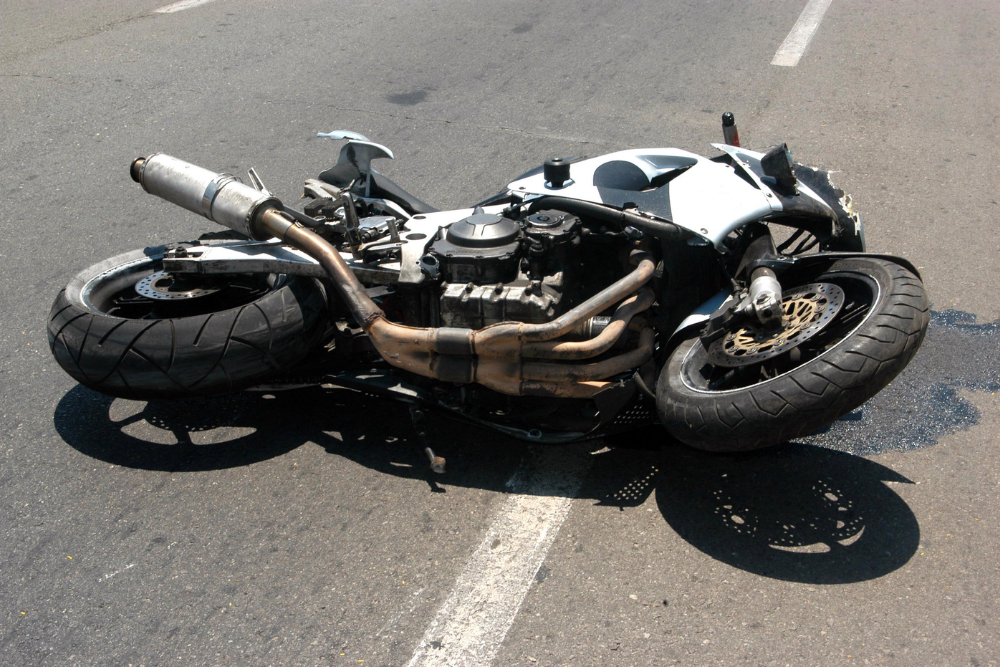Side Swipe Motorcycle Accidents In Pennsylvania

While you might always try to observe the traffic laws and exercise defensive driving while riding on your motorcycle, you still have a risk of being involved in a motorcycle crash. Motorcycle wrecks can result in catastrophic injuries because of the lower weights of the bikes as compared to other vehicles, their smaller sizes, and the lack of protection for the motorcyclists who ride them.
One type of motorcycle collision that is fairly common and can have devastating consequences is a sideswipe accident. This type of accident can occur suddenly when a car or truck traveling in an adjacent lane suddenly swerves over the line and strikes a motorcyclist. If you have been injured in a sideswipe motorcycle accident, you should speak with a motorcycle accident injury lawyer at Raynes & Lawn to learn about the potential legal remedies you might pursue.
What Happens In A Sideswipe Motorcycle Accident?
Sideswipe motorcycle accidents happen when a motorist swerves into lanes in which motorcyclists are traveling, hitting the bikes from the side.
These types of motorcycle crashes are frequently caused by the following types of negligent driving behavior:
- Changing lanes abruptly without signaling
- Failing to check for motorcycles in the rear or side mirrors
- Inattentive driving
- Drowsy driving
- Distracted driving
- Drunk or drugged driving
The National Highway Traffic Safety Administration (NHTSA) published a report analyzing lane-change crashes. It found that most sideswipe accidents involve drivers who fail to look to the sides or front to check for motorcyclists or to otherwise compensate for the presence of blind spots.
Types Of Injuries Sustained In A Sideswipe Motorcycle Accident
Sideswipe motorcycle accidents can cause devastating injuries and might leave a motorcyclist with permanent disabilities.
Some of the common types of injuries that can happen in sideswipe accidents involving motorcycles include the following:
- Bone fractures of the extremities that are contacted by the vehicle’s side
- Traumatic brain injuries that are especially likely if the motorcyclist was not wearing a helmet or was thrown from the bike
- Spinal cord injuries that can result in paraplegia or quadriplegia
- Whiplash caused by a violent jerking of the motorcyclist’s neck and head when traveling at high speeds
- Road rash from being thrown and skidding across the pavement
- Internal bleeding caused by internal organ damage
- Severe lacerations from the motorcyle landing on the rider or from the vehicle’s side
Possible Damages To The Vehicles
While both the vehicle and the motorcycle can be damaged in a sideswipe accident, the motorcycle often will suffer more extensive damage. Some of the types of damage to a motorcycle in a sideswipe accident include superficial or structural damage. The motorcycle might also be so damaged that it is totaled by the insurance company.
Superficial damage might include scratched, streaked, or stripped paint. This is especially likely if the motorcycle slid after being struck. Other parts, including mirrors, fenders, and wheels, might be dinged or dented.
A motorcycle might also sustain structural damage to its major components, including the engine components, suspension, or gas tank. This type of damage can require extensive repairs if the bike is not totaled. In a severe accident, the insurance company might total the bike and write it off as a complete loss.
Because of the focus on increasing the side-impact safety of passenger vehicles, modern cars have reinforced doors and passenger compartments. They also have higher beltlines for housing side-impact airbags. These features also mean that motorcyclists have a higher property damage and injury risk when they are sideswiped by passenger vehicles.
Side-Swipe Accident Liability
Most motorcycle sideswipe accidents occur because of the motorist’s negligence. A person is negligent when he or she behaves in a way that a reasonable person would not have acted in a similar situation. If a motorist fails to follow traffic rules or to check his or her blind spot for a motorcyclist, the driver might be liable in a motorcycle accident claim.
Before you can recover damages, you must prove all of the following negligence elements by a preponderance of the evidence:
- The defendant had a duty of care he or she owed to you.
- The defendant breached or violated the duty of care.
- The defendant’s breach of the duty of care caused your accident and injuries.
- You suffered calculable damages.
To prove these elements, you will need to present evidence to show that the accident more likely than not happened in the way that you have argued. If you can’t prove one of the elements but can still prove the remaining three, you still won’t prevail. To help you prevail in your claim, your attorney will conduct an in-depth investigation of your accident and what happened. He or she might work with an
accident reconstruction expert and accident investigators to gather evidence to support each of the elements. He or she might also interview witnesses who saw what happened. Third-party witnesses often provide critical support to motorcycle accident claims.
An experienced motorcycle accident attorney can also help you avoid making critical errors that could potentially harm your claim by handling all of the communication with the insurance company for you. Your attorney can make certain that your lawsuit is filed within the limitations period to preserve your recovery rights and negotiate on your behalf to try to secure a full and fair settlement for your losses. Finally, if your claim cannot be resolved outside of court through a settlement, your attorney can prepare your case for trial and litigate on your behalf until a verdict is reached.
Contact A Motorcycle Accident Lawyer
If you have been injured in a sideswipe motorcycle accident that you believe was caused by the other driver, you should speak to the attorneys at Raynes & Lawn. We can review your case and help you determine your next steps. Call us today at 1-800-535-1797 for a free consultation.

For the general public: This Blog/Website is made available by the law firm publisher, Raynes & Lawn, for educational purposes. It provides general information and a general understanding of the law but does not provide specific legal advice. By using this site, commenting on posts, or sending inquiries through the site or contact email, you confirm that there is no attorney-client relationship between you and the Blog/Website publisher. The Blog/Website should not be used as a substitute for competent legal advice from a licensed attorney in your jurisdiction.
For attorneys: This Blog/Website is informational in nature and is not a substitute for legal research or a consultation on specific matters pertaining to your clients. Due to the dynamic nature of legal doctrines, what might be accurate one day may be inaccurate the next. As such, the contents of this blog must not be relied upon as a basis for arguments to a court or for your advice to clients without, again, further research or a consultation with our professionals.

